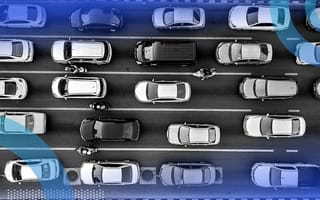From hurricanes throughout the southeast to wildfires in the west, severe weather-induced evacuations are causing a troubling level of traffic congestion in the U.S.
As we enter the peak of hurricane season, it’s time to think critically about implementing AI and cloud-based technologies that can adjust to changing traffic patterns in an emergency.
AI-Powered Vs. Legacy Traffic Tech
- AI-powered traffic lights use sophisticated algorithms to analyze real-time data and traffic patterns.
- Traditional traffic lights operate on predetermined timers.
Why Can’t We Keep Up With Traffic?
Is it inevitable that every evacuation will result in patience-eroding, bumper-to-bumper traffic? The answer is both no and yes.
While traffic engineers and planners have evacuation plans in place for most cities, it is unlikely that either those in charge or the general public will follow these plans properly — as we can see from the congestion on the nation’s freeways during rush hour every day.
This is due to outdated infrastructure, where legacy traffic technology simply can’t handle drastic pivots in a short amount of time, especially during severe weather events. But now we have technology that can.
How Can AI Alleviate Evacuation Stress?
Today’s AI systems examine and learn from traffic movements to optimize traffic flow, even when traffic patterns shift suddenly. These AI systems are designed to assess traffic situations by combining data from multiple sources, such as traffic sensors and cameras.
They then orchestrate the city’s traffic lights, enabling cars, transit buses, and emergency response vehicles to pass through intersections fluidly, even during high traffic. The systems even provide real-time insights on which transit buses are receiving priority, getting green lights first, along with daily reports of performance metrics.
As an added bonus, these systems are budget friendly for cities since they don’t require building new traffic intersections or vehicle hardware.
How Cloud-Based Systems Improve Mass Transit Tracking
Advanced cloud-based open architecture transit signal priority systems — or systems that reduce delays for buses and other mass transit vehicles at intersections — now combine asset management for continuous data technology upgrades and automation. This produces a system capable of serving an entire region.
The cloud removes the need for vehicle detection hardware at intersections. To better manage these buses and emergency vehicles, agencies typically have tracking devices on each of their vehicles to report to their computer-aided dispatch and automatic vehicle location software.
With vehicle locations known in near real-time, software and networking can now be used to bridge the gap between transit vehicles and city signals to facilitate transit priority in a more reliable, sustainable and intelligent way.
A “Vectorized” Approach
This enhanced tracking ability enables both priority calls from greater distances away from signals and priority calls coordinated among a group of signals. This method of placing priority calls to traffic signals is more sophisticated and is no longer constrained to fixed point locations.
Unlike the current state-of-the-art method of placing priority calls from the detection of buses at specific locations that starts a pre-programmed time of arrival, today’s solutions use a “vectorized” approach.
What do vector and magnitude mean in traffic terms?
In mathematics, a vector is an arrow representing a magnitude and a direction. In today’s advanced traffic management software, the arrow points in the direction of the traffic light and the magnitude is the travel time.
When the system is set up, traffic signals, bus routes, and bus stops all receive a digital representation on this vector. This produces a digital geospatial map where software can then track bus progression along bus routes. This results in a system that can dynamically place transit calls regardless of its location.
Instead, the system makes precise priority calls based on the expected time of arrival, which is the basis for all TSP check-in calls supported by all signal controller vendors. And due to the nature of the tracking algorithm, any significant changes to ETA can be adjusted. For example, if a bus was predicted to skip a bus stop but didn’t, the system will detect the change and adjust the priority call accordingly.
How the Cloud Maximizes a Continuous Drive
Cloud-based web portals show the real-time location and activity of emergency vehicles and area buses, including current assigned route, speed, bearing, next stop, on-time performance, and traffic priority status.
In addition to individual bus data, the cloud integrates other real-time data for display, including the state of traffic signal phases (green, yellow, red, etc.) for signals within each transit region. There is also an additional portal that reports the daily transit signal priority performance for each bus approach of every pilot intersection.
To enable safe and secure connections with traffic signals, each city receives a single device — the only additional hardware required — that serves as the critical link between city traffic signals and the AI platform. It’s designed to securely manage the information exchange between traffic lights.
These cloud-based TSP systems consider the global picture of a route and use machine learning to predict the optimal time to grant the green light to transit vehicles. In real time, it minimizes the interference with crisscrossing routes and maximizes the probability of a continuous drive.
AI Keeps Us Safe and on Time
With this technology now at our fingertips, cities and municipalities have the technology they need to properly accelerate the build-out of intelligent transit networks to benefit everyone. As more of these solutions are utilized across the country, we can move people through cities and communities safely and on time, even when we face stress from dangerous weather-related evacuations.





